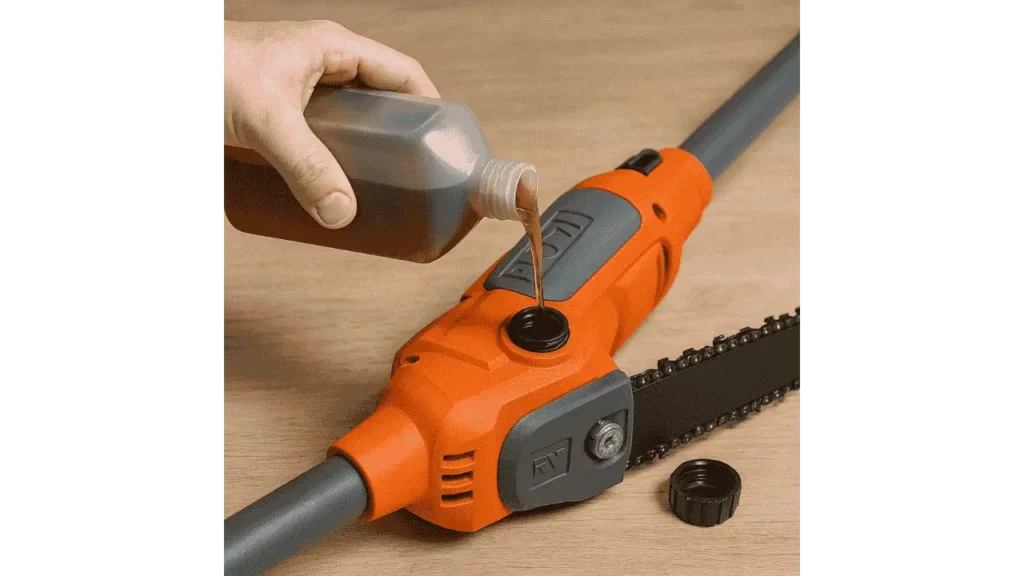Ryobi pole saws are known for their durability and ease of use, but to keep them running efficiently, regular oiling is essential. Proper lubrication reduces friction between the chain and guide bar, preventing premature wear and ensuring smooth cutting. If the chain isn’t getting enough oil, it can overheat, become dull quickly, and strain the motor. Whether your Ryobi pole saw has an automatic oiling system or requires manual oil application, this guide will walk you through the proper steps to maintain its performance.

Does a Ryobi Pole Saw Need Regular Oiling?
Like all chainsaws, Ryobi pole saws require consistent lubrication. Most models feature an automatic oiling system that continuously applies oil while the saw is in use. However, even with this feature, you must regularly check the oil reservoir to ensure the system is working correctly. A dry chain can lead to dangerous kickbacks, excessive heat buildup, and long-term damage to the motor and chain.
Steps to Oil a Ryobi Pole Saw
Step 1: Turn Off the Saw and Take Safety Precautions
Before handling oil or adjusting the saw, always turn off the power. If you have a battery-operated Ryobi pole saw, remove the battery. For corded electric models, unplug the saw. If you’re using a gas-powered Ryobi pole saw, turn off the engine and allow it to cool completely. Wearing protective gloves is recommended to prevent oil from getting on your hands and to avoid contact with sharp chain teeth.
Step 2: Locate the Oil Reservoir
Ryobi pole saws come with a built-in automatic oiling system, making lubrication easier. Locate the oil reservoir near the guide bar and inspect the oil level through the transparent viewing window. If the oil level is low, it’s time to refill it to maintain proper lubrication.
Step 3: Choosing the Right Oil
Using the right type of oil is important for optimal performance. Bar and chain oil is specifically designed for chainsaws and pole saws, providing the best lubrication and protection. Do not use motor oil, vegetable oil, or general-purpose lubricants, as they lack the viscosity needed to reduce friction effectively.
Step 4: Refilling the Oil Reservoir
To refill, unscrew the oil cap and carefully pour bar and chain oil into the reservoir. Avoid overfilling, as excess oil may leak during operation. After refilling, securely tighten the cap to prevent spills. If your model has an adjustable oil flow feature, ensure it is set to the recommended level for efficient lubrication.
Step 5: Testing the Oil Flow
After refilling, run the pole saw for a few seconds and observe the chain. A properly lubricated chain should appear slightly glossy and leave a thin film of oil on a test surface, such as a piece of wood or paper. If no oil is being distributed, check for clogged oil ports and clean them using a small wire or compressed air.
Step 6: Manual Oiling for Extra Protection
Even though Ryobi pole saws typically come with automatic oilers, applying a small amount of bar and chain oil manually before starting a job can provide additional protection, especially for extended cutting sessions. Use an oil can or squeeze bottle to coat the chain and guide the bar lightly. Rotate the chain by hand to distribute the oil evenly.
Conclusion:
Properly oiling your Ryobi pole saw ensures smooth operation, extends the lifespan of the chain and guide bar, and keeps the motor from overworking. Whether your model features an automatic oiling system or requires occasional manual lubrication, maintaining the correct oil levels is essential. By regularly checking the oil reservoir, using the right oil, and keeping the system clean, you can ensure that your Ryobi pole saw remains in peak condition for all your pruning and trimming needs. Routine maintenance will help prevent costly repairs and keep your saw running like new for years to come.
- How Many Watts Does a Pole Saw Use? - July 4, 2025
- How Long Is a Pole Saw? - July 3, 2025
- How Much Does a Pole Saw Cost? - July 2, 2025
